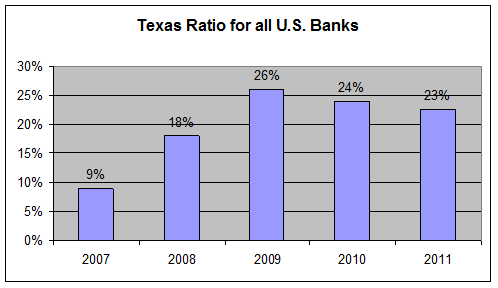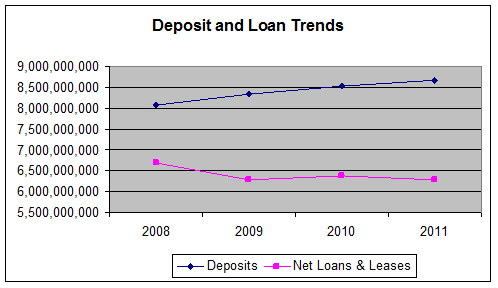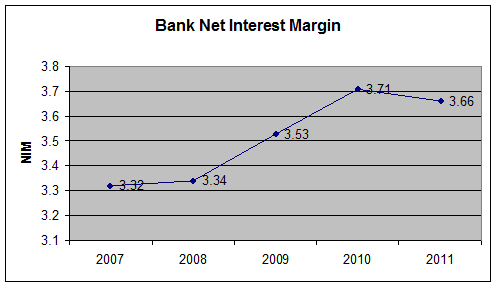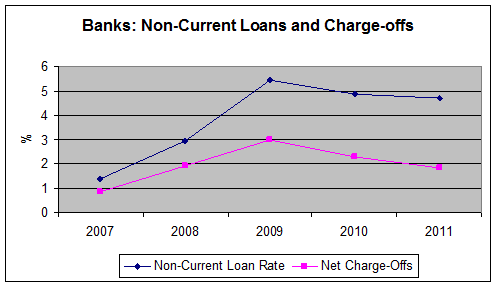First quarter 2011 financial data from the FDIC has been released and we've gone through and crunched the numbers to give you an idea of what is happening to the U.S. banking system. We'll do a credit union update shortly. You can now also view updated financial information for every bank and credit union in the United States when you click on any bank profile on BestCashCow. Here's an example for the biggest bank by assets in our database, JP Morgan Chase Bank .
Why Is This Important?
Every bank on BestCashCow is FDIC insured and almost every credit union is NCUA insured. So why is it important to understand the overall state of the banking sytem?
- It gives you clues about what is going to happen to rates and loan availability in the future.
- Since banks led the country into the great recession, their financial condition provides clues to how the economy is recovering (or not recovering).
- Bank failures can impact you even if your deposits are covered by FDIC insurance. See the bottom of this article for more on how this happens.
Bank Texas Ratio

The Texas Ratio measures the amount of non-performing loans and repossessed property a bank holds versus the capital and loan loss reserves set aside to cover losses. If the Texas Ratio gets above 100%, then the bank, or banking system may not have enough capital or reserves to cover future losses. The lower the Texas Ratio the better. Analysis of failed banks show that most have Texas Ratios over 200%.
The overall Texas Ratio for U.S. banks spiked between 2007 and 2009 but is now slowly coming down. As the chart shows though, the ratio is far from its 2007, pre-crisis low of 9%. The banks are not out of the woods yet.
Looking at the Texas Ratio regionally shows that not all states are created equal. Rhode Island continues to maintain the lowest Texas Ratio at 9.38% while Georgia has the highest ratio at 71.31%. Like our State Texas Ratio analysis last quarter , the New England states continue to have the "safest" banks in the country according to the Texas Ratio.
Q1 2011 State Texas Ratios
| Texas Ratio | State |
| 9.377123 | RI |
| 10.79868 | VT |
| 10.95741 | AK |
| 11.43802 | MA |
| 11.59921 | NH |
| 12.14206 | ND |
| 12.76239 | NE |
| 14.56197 | NY |
| 14.81966 | CT |
| 15.57897 | PA |
| 15.95 | IA |
| 16.6383 | WV |
| 16.64741 | ME |
| 17.96092 | OK |
| 19.40542 | WY |
| 19.45681 | NV |
| 20.15415 | TX |
| 20.61977 | UT |
| 20.72108 | NJ |
| 21.19567 | KY |
| 21.98898 | SD |
| 22.7225 | CA |
| 22.81296 | IN |
| 22.98189 | MS |
| 24.04041 | GU |
| 24.45765 | OH |
| 24.56896 | VA |
| 25.9541 | KS |
| 26.39548 | HI |
| 27.59824 | MO |
| 28.0948 | LA |
| 28.45942 | NM |
| 29.07192 | MT |
| 30.24131 | AR |
| 30.35663 | AZ |
| 31.08899 | WI |
| 31.72156 | TN |
| 31.81913 | MI |
| 32.81521 | MN |
| 34.07657 | DE |
| 36.3162 | IL |
| 36.73541 | MD |
| 37.10521 | ID |
| 40.72648 | WA |
| 41.35058 | DC |
| 42.53756 | OR |
| 44.25963 | AL |
| 46.51442 | CO |
| 49.21768 | SC |
| 50.68143 | NC |
| 51.75952 | FL |
| 71.30841 | GA |

Deposits at banks have grown since 2008, from $8,082,229,710 to $8,674,568,188 while loans have decreased from $6,681,788,739 to $6,279,076,894. So, banks are pulling back on lending while stockpiling deposits. As a result, banks feel very little need to compete for deposit dollars and feel little pressure to keep up rates. They are awash in cash!
Everyone knows rates have come down but for the last couple of years banks have been able to make more money off this decrease in rates. The rates they pay on deposits have come down faster than what they pay on loans. That makes sense because banks have lots of longer-term loans locked in at higher rates (think 30 year mortgages, etc.) while the longest standard deposit is a 5 year CD. The difference between what they pay on deposits and what they earn on loans is called the Net Interest Margin (NIM). The chart below shows NIM spiked after the financial crisis as the Fed brought down the Fed Funds rate and the cost of bank deposits dropped. Notice though, how it has leveled off. There are two reasons for this:
- Deposit rates cannot drop much further.
- Higher interest loans and leases held by banks are rolling off or being refinanced.
Look for NIM to continue to decline if the interest rate environment does not change. Also, look for banks to work hard to lock consumers into 5 year CDs (or even longer maturities) at the currently super-low rates. If the economy does not improve banks will not feel the same urgency but they will face margin pressure as NIM continues to come down.

So, banks have made good money from a favourable interest rate environment. That has helped them reduce or cover the bad loans on their books. An improving economy has also helped. Non-current loans and charge-offs peaked in 2009 and have been coming down. If the economy continues to improve look for this trend to continue. This will help bank profitability since they will not need to set aside as much cash to cover bad loans. It will also help banks on the edge from going over and failing.

The data suggests that the worst is over for the banking system and it is slowly healing. The mending has come at a huge cost to consumers though. Not only have we had to bail out the banks with infusions of capital (TARP), but in essence we have been subsidizing the banks via extremely low interest rates (remember the NIM data). Banks are sitting on a pile of cash and eventually this will enter the economy. Rising rates may actually spur greater bank lending as banks may be waiting to lend money when the can make more. Indeed, Wells Fargo hinted at this in a conference call with analysts, saying they wanted to "keep their powder dry."
It may be obvious, but if the economy continues to improve look for rates to rise, and for loans to credit worthy borrowers to suddenly become much more available.
If there is other data you would like to see if in future updates, leave a comment below. I welcome any comments and thoughts.











Add your Comment
use your Google account
or use your BestCashCow account